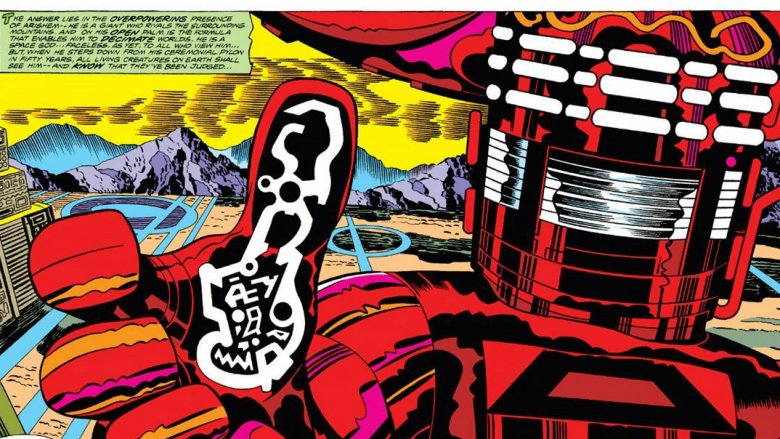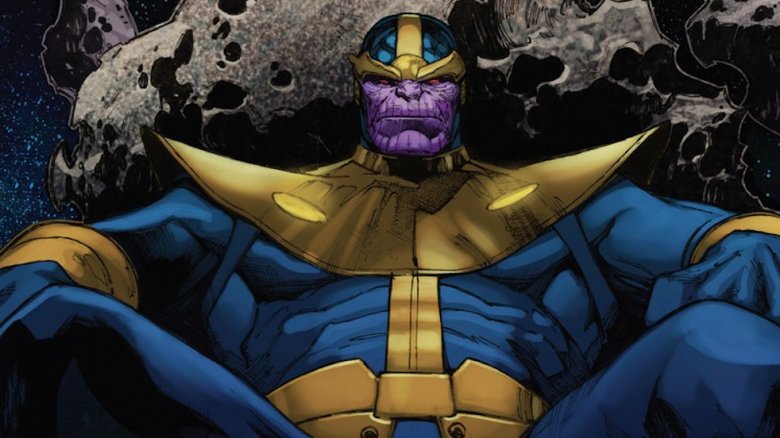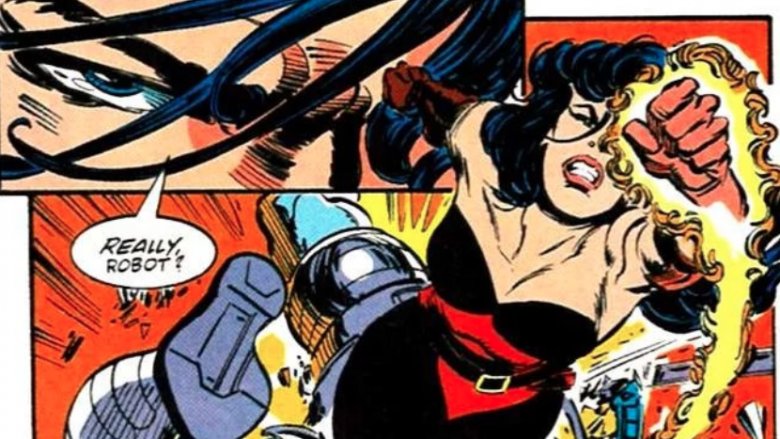The Untold Truth Of The Eternals
We're just now starting to understand the outline of where Marvel's taking the MCU during Phase 4. In the wake of Avengers: Endgame and Spider-Man: Far from Home, there's a new status quo following Thanos' catastrophic Snap, and it includes the longtime Marvel Comics fixtures known as the Eternals.
We now know that Marvel will be incorporating the Eternals into Phase 4 of its cinematic slate, which means audiences are in for a fairly wild ride. The Eternals are a cosmic race residing on Titan, the moon of Saturn. They've already got a stealthy presence in the form of a certain villain in the franchise, and if Marvel embraces all the cosmos-spanning insanity of the books, viewers have some technicolor treats in store. Given that this crew is already well on its way to theaters, there's no better time to peer into this fascinating corner of Marvel's tapestry, full of bizarre history and intriguing mystery. This is the untold truth of the Eternals.
Gone too soon
The Eternals were created by comics legend Jack Kirby during his final tenure at Marvel Comics. He came back to the company after an extended break during which he worked for DC Comics creating characters like The Demon and pioneering the Fourth World Saga. Upon his return to Marvel he created Devil Dinosaur and a little group of characters called The Eternals. Kirby's first comic featuring the characters dropped in 1976 and introduced readers to the children of the Celestials. The Eternals are an ancient race of superbeings who have long had their hands in the game of protecting Earth from evil, specifically the rule of the treacherous Deviants. The series tells a meticulously plotted tale and was created with a finite ending in mind. Unfortunately, Kirby never reached his intended finale.
Much like Kirby's Fourth World books at DC (which ended unresolved until The Hunger Dogs was published) The Eternals was axed at issue #19 before Kirby had a chance to wrap up all of the existing plot threads. It lingered unfinished for a while until Roy Thomas and Mark Gruenwald used a storyline that ended with Thor #301 to wrap up the tale of the Eternals' cosmic crusade. We're glad the story ended up resolved but we'll always be wondering what it could have looked like if Kirby had a chance to finish the series as he intended.
Tomb of the Space Gods!
While they were the ones who had their name on the cover, the most prominent contribution to the larger world of Marvel Comics to come from the pages of The Eternals wasn't actually the Eternals themselves. Instead, it was the Celestials — the "Space Gods" that created the Eternals, the Deviants, and, it turns out, pretty much all sentient life in the Marvel Universe.
Like other themes and ideas explored in the pages of The Eternals, the Celestials were an example of Jack Kirby building on an idea he'd explored in other comics. In this case, they were a step past Galactus, who he and Stan Lee had created in Fantastic Four: a massive humanoid that was essentially a living force of nature with ties to the origins of the universe. Even their designs were similar, clad in Kirby's trademark elaborate armor, but there was one crucial difference that set these cosmic forces apart. Galactus had a recognizable human face that could be seen even underneath his helmet. The Celestials, on the other hand, were completely covered by their armor, making them far more unknowable than even the Devourer of Worlds had been.
Instead, the Celestials were defined by the ongoing experiment in creating life that they'd been tinkering with for billions of years, with names that indicated their function. Gammemnon the Gatherer, for example, was charged with acquiring samples of life from across the universe. Arishem the Judge, who had "the formula for world destruction inscribed on his thumb," would determine whether a planet's population would live or die once the experiment had run its course, and Exitar the Exterminator... well, that one's pretty obvious.
The combination of bombastic sci-fi and the Lovecraftian horror of these incomprehensible space gods who viewed all of humanity as the equivalent of a science project proved to be appealing to both readers and creators, and while characters like Ikaris were often overlooked, the Celestials were woven into the fabric of the Marvel Universe, with connections to everything from the X-Men to the Infinity Stones. The Avengers have even been headquartered in a building made from the body of a long-dead Celestial. Recycling is important, even in superhero housing.
MAXed out
Marvel MAX is one of the publishing innovations that helped bring the company back into the spotlight in the early aughts. It's hard to imagine today but during that time Marvel was actually struggling in a big way (they even filed for bankruptcy at one point). Marvel MAX, which allowed for more mature storytelling as well as mature language, brought attention back to the publisher and gave it gems like Alias, the series that introduced the world to Jessica Jones. Unfortunately, not every MAX title ended up a hit.
The Eternal is writer Chuck Austen's reimagining of The Eternals. The series sees Ikaeden, leader of the Eternals, effectively creating humankind and using it to mine Earth's resources for the Celestials. It went over horrendously, garnering criticism for being both mean-spirited and for having little to do with the original Eternals at all. While it was originally planned as a long-form series, it ended up cancelled after just six issues. Unlike the original series though, nobody particularly cared if this one ever came back. To this day it hasn't.
Heroes need villains
You can't create a team of superheroes without giving them a proper antagonistic force. Characters Kirby created like Magneto and Doctor Doom are what made the X-Men and the Fantastic Four so great to begin with. There always must be a Loki to the Thor and Kirby knew this good and well when approaching the Eternals. He certainly wasn't going to leave them to squabble amongst themselves. He gave them the Deviants.
The Eternals are the creation of the Celestials, the beings that are effectively responsible for shaping the Marvel universe as we know it. When the Celestials create the Eternals, they also create the Deviants, a horrifying race of creatures that are, physically, the opposite of the beautiful humanoid Eternals. The two species are caught in a constant war between one another, with Deviants forming a sort of natural opposition to the Eternals. No Deviant mutation is repeated in their species, each physical anomaly or superpower being entirely unique to the Deviant who possesses it. They are, effectively, mutations of the Eternals. The species have been at war with one another from the start, with Deviants residing on Earth and conquering much of early humanity (except for Atlantis). The Eternals end their reign, though Deviants still reside on Earth to this day and clash with Eternals regularly.
They've already appeared in the MCU
It makes sense that the filmmakers behind the MCU would bring the Eternals into play. They already have a tie to the world at this point. Eternals like Starfox, Sersi, and Makaari can already be easily introduced to the world through their family's presence in the MCU in the form of the Mad Titan himself, Thanos.
Thanos is perhaps the most famous of the Eternals. While he wasn't technically introduced in the original Kirby series, comic creator Jim Starlin (the man who created Thanos) designed him as an extension of their world. Thanos is a Deviant child of an Eternal mother and father, a being born into a world that instantly rejected him. His mother is so disgusted with him from birth that she tries to kill him as a child. His traumatic childhood only furthers his fascination with Death and eventually leads to his becoming the Mad Titan. While he's very rarely associated with the Eternals directly these days (or at all in the MCU), he's very much a product of theirs both literally and figuratively.
Asgard's on their side
The Eternals' relationship with their creators, the Celestials, is a bit turbulent. They've at times found themselves on opposing sides of the battlefield. The Celestials, being giant omnipotent immortal beings, are pretty hard to take on in battle, so it makes sense that on what may be the most famous occasion during which the two races came to blows, the Eternals didn't go at it alone.
Who better to take on the Celestials than another race of gods? The Eternals offered their aid to the forces of Asgard when the two sides found themselves at odds with the Celestials. The Eternals formed the Uni-Mind (a massively powerful composite of several Eternals, somewhat akin to a Megazord) while Odin possessed the Destroyer armor and enlarged it to be the size of the Celestials (also somewhat akin to a Megazord now that we think about it). It might not get the recognition the Avengers and X-Men do whenever they join forces, but we think it's one of the cooler moments in the history of the Eternals. A bunch of giant mega-powerful space gods and robots duking it out is good comics as far as we're concerned.
Literary roots
Part of what made Kirby such an astoundingly resonant creator was the way he integrated literary influence into the worlds and characters he created, elevating the genre of superhero comics to new heights. The stories were often more inspired by timeless literary classics than they were by other comics. His Thor stories are very much Shakespearean while the Fantastic Four draws heavily from sci-fi literature and classic monster movies. It only makes sense that he'd carry that ethos into creating the Eternals.
Kirby is on the record as naming two novels as primary influences on the series. The first is sci-fi master Arthur C. Clarke's Childhood's End. This novel in particular influenced Kirby's interpretation of the Celestials as well as the Uni-Mind. He also drew heavily from Erich von Daniken's Chariot of the Gods, a nonfiction book that posits the idea of alien gods. He acknowledged his debt to this novel in dialogue with fans of The Eternals. It's proof that the best way to tell great stories is to draw inspiration from a wealth of sources, not just from the medium or genre in which you're working.
Starfox can't handle the truth
Thanos and his brother Starfox are just about as polar opposites as you could possibly find. Thanos is a giant purple death-worshipping supervillain. Starfox, on the other hand, is a conventionally attractive ladies' man with perfectly coifed hair who fights on the side of good. That being said, Starfox is far from squeaky clean. His superpower allows him to effectively make people attracted to him (his rather appropriate real name is Eros, the name of the Greek god of love) and that's occasionally gotten him into legal trouble.
He's specifically put on trial for sexual harassment by a married woman who claims that he used his powers to seduce her. His lawyer during this case is none other than Jennifer Walters, better known as She-Hulk. It's a story that could be taken as a one-note joke but instead becomes a genuinely compelling look into the ethics of Starfox's powers. It comes to light that he's used them to not only make people attracted to him but to influence the feelings of others. He's responsible for Walters' marriage to John Jameson and is briefly convinced that he triggered Thanos' initial infatuation with Death. The story ends with Starfox agreeing to have his powers shut down so that he won't be able to hurt anyone else with them.
Flash Fact: Makkari isn't fast enough
There's something about super-speed that just feels right. It's not too complicated. It doesn't make the user omnipotently powerful. It's perhaps the most perfect superpower. As such, it makes sense that there are so many superheroes and villains that wield it as a power in comics. Marvel alone has Quicksilver, Whizzer, and among others, Makkari, who is a member of the Eternals family. The fastest person in the Marvel Universe, however, is the Flash. Well, kind of.
In Mark Gruenwald's Quasar run a particular issue features a grand race between all of the speedsters in the Marvel universe, including Makkari. The one that comes out on top, however, isn't a character we've seen before. He's an amnesiac from a different universe. Even he doesn't remember his real name, though he seems to recall it being something like "Buried Alien." Recently over at DC Comics the Flash, also known as Barry Allen (get it?), had perished in Crisis on Infinite Earths. Gruenwald very clearly included Buried Alien as an homage to the character.
It's pretty cheeky, especially considering that Alien is the one who wins the race. It makes it more or less canon that the fastest person in the Marvel Universe is a DC character, with Buried Alien even being dubbed "the fastest man alive," long a moniker of the Flash.
Sersi and Steve, sitting in a tree
The Eternals, as a whole, keep to themselves. Their stories are often pretty contained and don't bleed out into the rest of the Marvel universe. Nonetheless, there are exceptions to every rule and the Eternal known as Sersi is one of them. Sersi is pretty largely integrated into the world of Marvel. She possesses a number of abilities including the ability to cast illusions, super strength, and teleportation skills. If you're thinking a being as powerful as she belongs on the Avengers, you wouldn't be too far off.
Sersi is, for a time, a member of Earth's Mightiest Heroes. She joins at the invitation of none other than Captain America. Her decision to join the team at the time is just as much motivated by her desire to do good as it is by her infatuation with the Star-Spangled Avenger, which she's harbored for quite some time. Her tenure on the team is finite and comes to a close after the Onslaught saga, but it inspires her to stay on Earth rather than return home to the Eternals. She has since aided the team on occasion, and while she's yet to properly woo Cap, we're sure she's not done trying.
The power of love
Long has Ultron been a thorn in the side of the Marvel universe. The robot, created by Ant-Man/general supergenius Hank Pym, has been terrorizing the heroes of Marvel since the day he was activated. He's fueled by an abject hatred of humanity, by the idea that they're inherently flawed and that Earth can only be saved by wiping them out. It's his sole mission, a crusade fueled by hate. So what happens when Ultron is introduced to the power of love?
Starfox's powers allow him to create feelings of infatuation, romance, and affection in anybody or anything. In the graphic novel Rage of Ultron, we see what happens when his powers meet the robot menace. In the story's finale, Pym and Ultron have merged into a singular being prepared to wipe out humanity once and for all. Starfox is able to defeat them by using his powers to introduce love into the equation. The encounter takes Ultron and Hank back to the moment the robot was activated and makes both of them re-evaluate it, recognizing the inherent love between the two of them.
Ultron's introduction to love (paired with Hank's presence in his consciousness) is enough to get him to back off and banish himself into the depths of space. Starfox's powers may make him a weird creep sometimes but he has at least once managed to use his powers of attraction to save the world.
The MCU Eternals
The Eternals was announced in April of 2018 as one of the more surprising entries in Phase 4 of the Marvel Cinematic Universe, but there was a hint of what was to come all the way back in 2014, with a brief cameo in another surprising (and successful) Marvel movie. In Guardians of the Galaxy, when the Collector is explaining the Infinity Stones, we get an unmistakable glimpse of a Celestial using the Power Stone to eradicate the population of some unfortunate planet. So yeah, in case you were wondering, Exitar the Exterminator made it into the MCU before Spider-Man.
Five years after that first glimpse of the eons-long saga of Eternals, Deviants, and Celestials, we finally got a better idea of what we can expect when The Eternals hits the screen in 2020. In a panel at San Diego's Comic-Con International where they revealed the upcoming slate of Marvel movies — including surprise announcements like a Black Widow solo film, Jane Foster becoming Thor, and the return of Blade to the big screen — we were introduced to the main cast. Interestingly enough, while the movie was originally billed as focusing on Ikaris and Sersi, the latter character was completely absent from the announcement.
Instead, we were introduced to Richard Madden, best known as Robb Stark from Game of Thrones, as Ikaris, Angelina Jolie as Thena, Salma Hayek as Ajak, stand-up comedian and Academy Award-nominated screenwriter Kumail Nanjiani as Kingo Sunen, former Miss Deaf America and Walking Dead actress Lauren Ridloff as Makkari, Atlanta's Brian Tyree Henry making his second Marvel appearance as Phastos (he was also Miles Morales' dad in Into the Spider-Verse), Korean megastar Don Lee as Gilgamesh, and Lia McHugh as Sprite. As for the plot, no details have been released as of this writing, but if the Celestials are hanging around the MCU obliterating planets — and they are — someone should probably deal with that.












